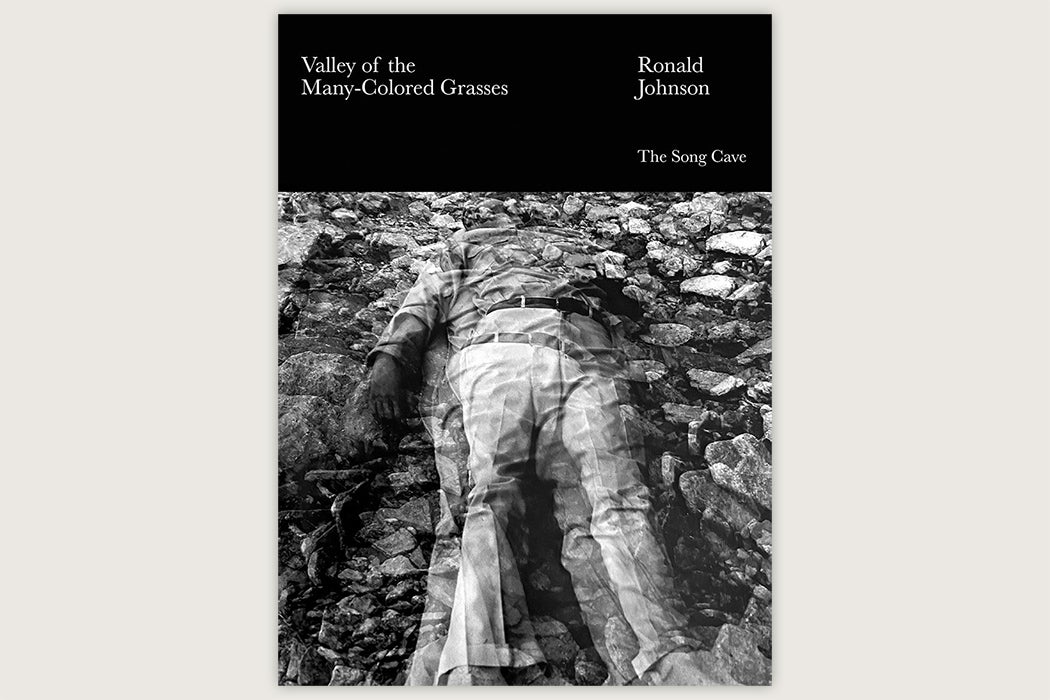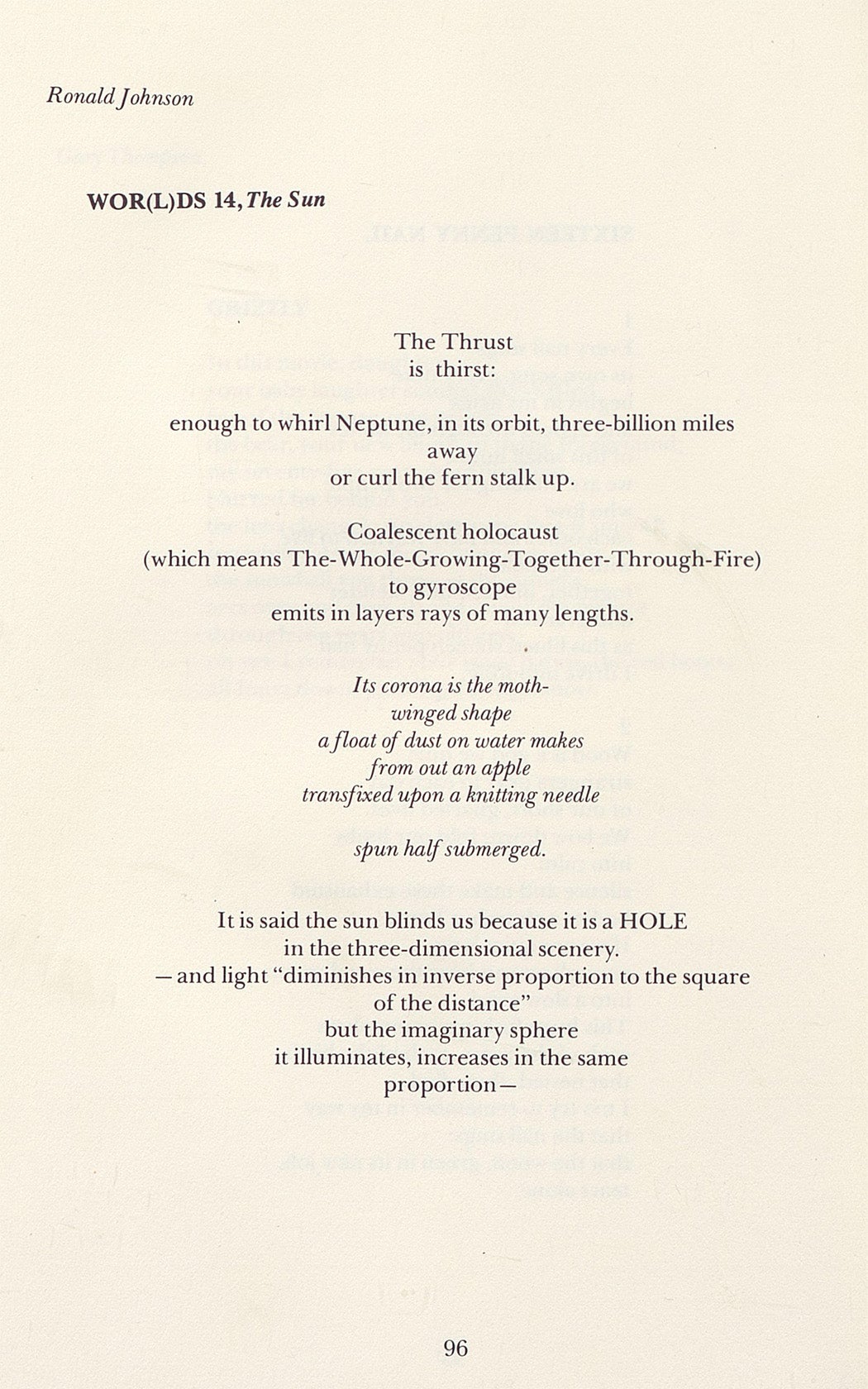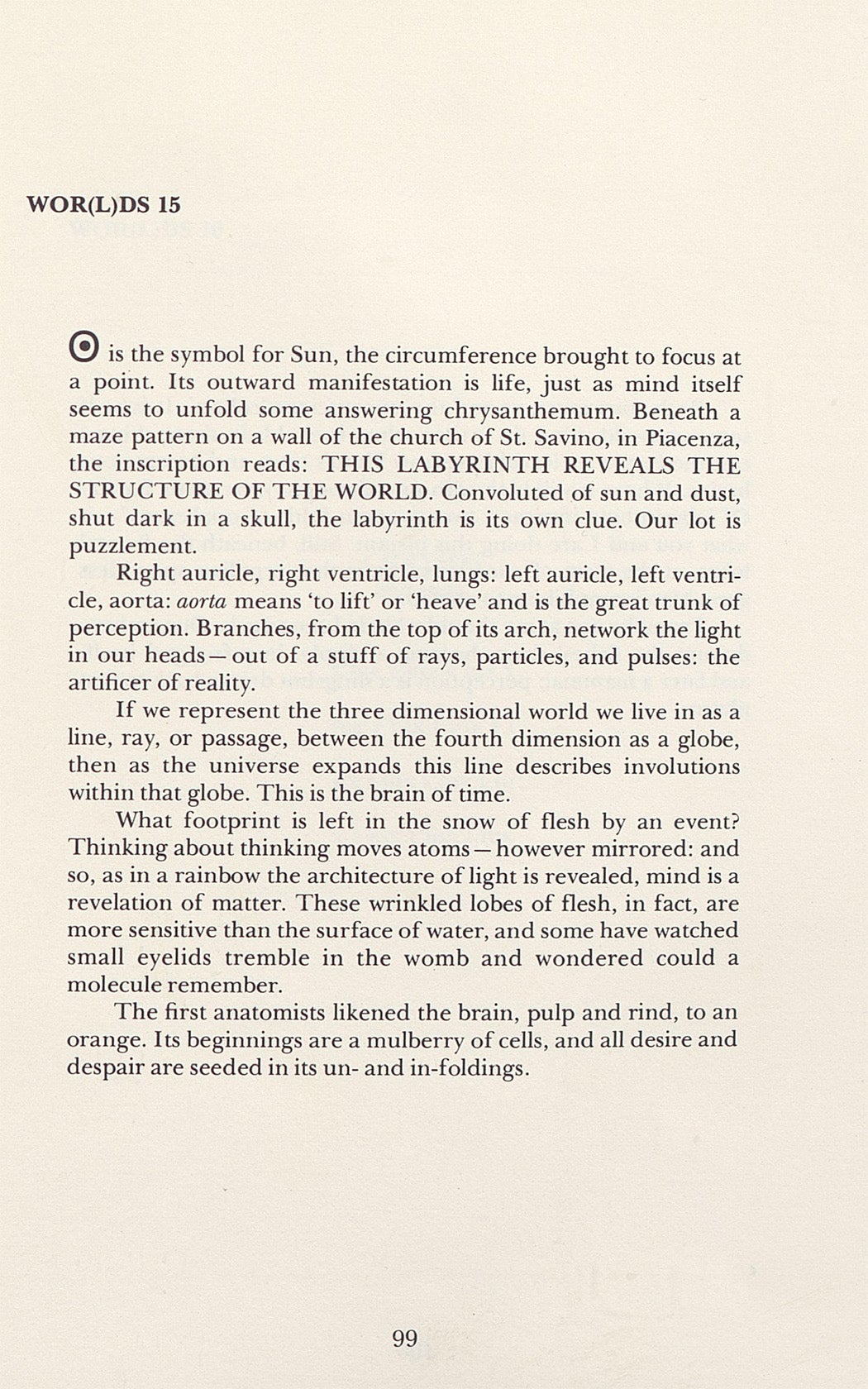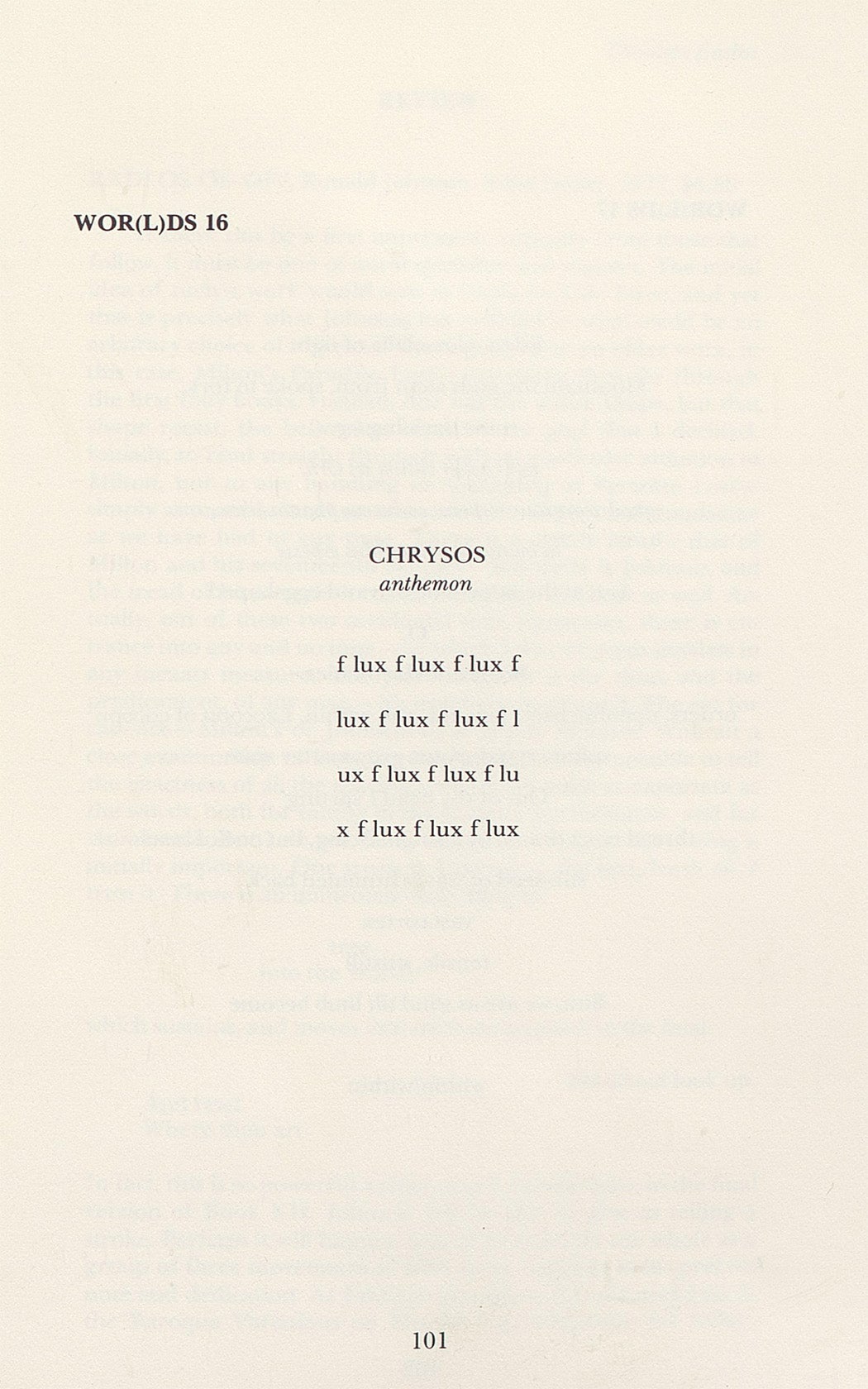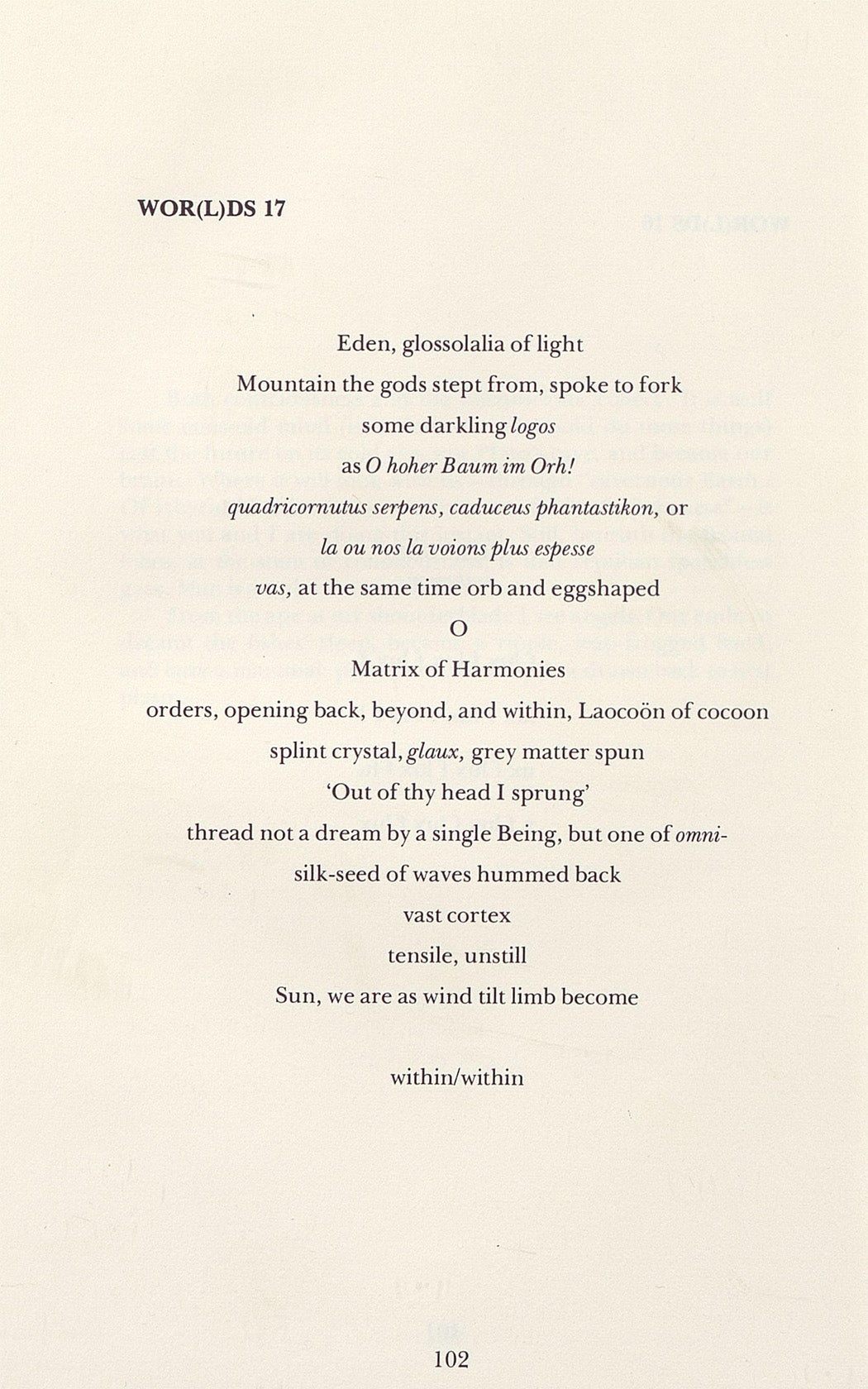Ronald Johnson had a strange—some might say perverse, or exceptionally obtuse—love affair with text. He was a poet who was not always understood, or even read, during his lifetime (he died in 1998 at age 62 of brain cancer). Some of his first books of modernist collage poetry were published by Norton to good reviews but, following his 1968 move from New York to California, he began devoting himself to long concrete epics, placing them with obscure presses, far from the East Coast literary machine. Over his life’s work, Johnson constructed a dynamic and visionary queer mythos, synthesizing textual elements from a range of written and real-life material, from his Kansas boyhood and The Wonderful Wizard of Oz to the Transcendentalists, avant garde music, and Objectivist poetry.
Until now, if Johnson was talked about at all, it was discussion of the work that since its completion in 1996 has been considered his magnum opus: a ninety-nine part concrete poem entitled ARK. Other instances centered on his 1977 book-length excision of Paradise Lost, RADI OS, (stylized “PARADISE LOST,.” on the title page). Among the first major literary works to utilize such a technique, it was incredibly influential for the tradition of collage artists who followed. Thus, for Johnson, as for other writers of modernist book-length poems—Louis Zukofsky (“A“) and Ezra Pound (The Cantos)—his embrace of the epic tradition led many of his shorter works to be viewed as inessential marginalia.
This was the critical perception of Johnson’s oeuvre when Valley of the Many-Colored Grasses (1969), his third book, was republished this past May by the Song Cave. It’s the final, summational work of his early collage period, comprised of shortened and re-arranged poems from his first published book, A Line of Poetry, a Row of Trees (1964), and a then-new cycle of poems called The Different Musics. The two parts showcase his revision and elaboration of the modernist collage aesthetic, aided by formal ideas taken from the symphonies of Charles Ives and his enduring interest in collapsing the order-chaos binary to achieve a “synergy of heightened quotation,” to quote Johnson’s good friend Guy Davenport.
Valley of the Many-Colored Grasses was initially released a year after Johnson moved to San Francisco, where he remained for over 25 years, supporting himself through bar and restaurant work and writing cookbooks (the most famous of which, The American Table, achieved cult renown for its documentation of American regional cooking), and beginning work on the long concrete poem “Wor(l)ds,” which eventually became ARK.
“Like his poem ARK, Ronald Johnson’s life can be seen in three parts,” wrote Peter O’Leary in the introduction to an interview he conducted with Johnson for the Chicago Review in the mid-90s. The first part of that life begins in Kansas, where Johnson was born in 1935, in the small prairie town of Ashland, and ends, after a few semesters at the University of Kansas, with the draft. The third part focuses on Johnson’s California period and ARK, among other late works. But it was over the ten-year course of his life’s second part that he composed the poems that made up Valley of the Many-Colored Grasses.
That ten-year period included two in the army, followed by a visit Johnson made to Washington D.C. in 1958, prior to enrolling at Columbia University. In D.C. he met Jonathan Williams, a man about five years Johnson’s senior who went on to have a formative impact on his life and work. Williams had studied at Black Mountain College, the influential experimental arts school in western North Carolina. When the school closed in the late ‘50s, he followed many others from the Black Mountain crowd in migrating to Manhattan, where he and Johnson began a romantic and creative partnership. Williams subsequently served as mentor, social guide, and publishing aid through his work with the Jargon Society, the independent publisher which issued Johnson’s first book in 1964.

In fact, it was Williams who first introduced Johnson to the “New American Poetry,” the emerging generation of modernists which included Charles Olson, Zukofsky, and William Carlos Williams, one of its older forerunners, and gained him entry into their literary and social circle.
“I was immersed in this world of wonderful creative people,” Johnson told O’Leary. “And so I began writing.” Since his poetic beginnings, Johnson had been attracted to collage. As a teenager, he “took snippets from newspapers that said something strange, just two words, or three words, and I made poems out of those and I made different forms and they were all pasted in a book.”
“My poetry may sound kind of mystical but I don’t think I’m mystical,” Johnson continued. “I guess I have had certain visions. But mostly it’s a work of the unconscious.” This point is illuminating, says O’Leary, whom Johnson named as his literary executor. “I think he really did put trust in the unconscious as the place from which the poetry fountains forth.”
O’Leary is sitting in his home office in Oak Park, Illinois, framed by a backdrop of wall shelves brimming with books, speaking over Zoom. In 1996, O’Leary was a young poet, still yet to publish his first book. “I began reading [Johnson’s] work in the late 1980s, and I encountered it with”—O’Leary reaches back and pulls a slim white volume from the shelf—“this copy of Ark: The Foundations,” the first of the poem’s three sections, published in 1980 as a standalone volume. A few years after reading it, O’Leary wrote Johnson a letter. To his delight, Johnson replied, and the two struck up a friendship and apprenticeship of sorts; Johnson offered revisions of O’Leary’s poems, which eventually went into Watchfulness (2001), O’Leary’s first collection. Interspersed with in-person meetings every year or two, their correspondence continued until Johnson’s death.
Now, 25 years on, Johnson’s unique position at the nexus of various poetic traditions makes his work ripe for reassessment. His second collection, The Book of the Green Man, represented what Johnson called his “attempt, as a brash American, to make new the traditional British long seasonal poem.” It was republished for the first time in 2015 and reprinted again last year. For Johnson, the collection’s newness was its ecstatic synthesis of two quite divergent strains of English poetry: the visionary allegory of William Blake and the contemplative, flora-toned Wordsworthian serenade. This unlikely literary marriage, much like that of Grasses’ discursive assemblage and Transcendent reflections on natural beauty, prefigures the intertwining trajectories of conceptual and ecopoetry—text and environment as shrinking forms.
As was also the case for Lorine Niedecker, another modernist for whom recognition of her unique, innovative poetics came posthumously, Johnson’s ongoing rediscovery seems to be noticeably accelerating a few decades after his death. For new readers, his early poems answer certain crucial questions: Where did our modern collage aesthetic come from? What was its incipient form? What was collage before multimedia? And wherein lies the textual pastoral?
For such readers, Valley of the Many-Colored Grasses offers the sinuous rush of geography and image—rolling like clear, green hills into the twiggy, branch-like slant of word and line. In a 1967 letter to the Scottish poet Ian Hamilton Finlay, Johnson says the underlying structural conceit of Grasses is that of a “natural abstraction”—one “of the circle, the plow-contour, spiral shell,” of a poetry which drinks from nature’s well, takes its form and atmosphere as nourishment, and flowers a corresponding image. In the first of “Four Orphic Poems,” which appear at the beginning of Grasses, this sprightly play between natural and word forms is laid out in manifesto-like fashion. Via quotation from Thoreau’s journals, Johnson situates his lines within a corresponding system. The syllable is the “I,” the “rock & flower & animal”; the text is the landscape, the harmonious center. Radiating out, beckoning in:
& I (like
Thoreau) sit here engrossed,‘between a microscopic & a telescopic
world’,
attempting to readthe twigged, branchy writing
of frost, spider & galactic cluster. That the syllables!
—rock & flower & animal
alike—
among the words,make Order.
Johnson modeled his New York poems on Olson’s poetics of allusion and discursion and the collage modes found in Pound’s Cantos. But in other, equally foundational respects, his poetry differed from that of his predecessors. Olson’s compositional emphasis lay in language’s roots in the poet’s own physiology (particularly the influence of breath on cadence and line). His voice, meanwhile, was at turns dogmatic and obtuse. Pound, on the other hand, sought to render history in poetic form by juxtaposing material from different eras and cultures. Johnson’s was a poetry much less ensconced in human history. His lines and stanzas from this period trickle, then flow, projecting space and movement in the poems’ articulations of order, harmony, and immediate experience of natural phenomena:
It is here—
(the growing walls
a ceiling greenabove me)
I have made clear spaceto cultivate
the Wild, Espaliered, Tangled
Clippedestate. Here—
both lines of poetry, rows
of trees,
shall spring allseasons
out ‘of the lust ofthe earth,
without
a formal seed’.
More often than not, the poems in Grasses contain quotations without attribution, and conversely, referents without accompanying quotation. Of the sources quoted and figures referenced in A Line of Poetry, a Row of Trees, nearly all are of American or English vintage (with the notable exceptions of Heraclitus and the Bengali poet Ramprasad Sen). There are quotations from works by various English poets and essayists, allusions to English and American painters, descriptions of buffalo hunting from the memoirs of a Texas plainsman, references to American modernist poets and avant garde composers, and material from an anthropological study of Plains Indian craftwork.
While the collection’s early poems evoke various visionary or geographically-specific stretches up and down the East Coast, often lush and green, newly-plowed or blooming, its middle section steadily gives way to areas of scrub grass and range land. The sequencing of poems, however, has no such obvious concrete effect as America rendered in text. The Kansas prairie intermingles with Emerson, Harry Partch, and Brooklyn Heights; the Potomac spills into swamp fires, Goethe, and Andrew Marvell. In time, they all flow into The Different Musics, which constitutes a major reversal of Johnson’s collage aesthetic: text which turns away from natural forms towards geometry, symmetry, and simultaneity of image.
The Different Musics, composed from 1966-68, draws from Johnson’s increasing interest in Charles Ives’ use of polyphony, in which a piece of music holds several different melodies and tonalities in tension. Johnson adapted this style for the page, using the same principle to undermine one’s linear experience of reading. In “Up Till Now,” an essay written just before Johnson’s death, he says: “From Ives, I learned how collage could be used to effect.” In the collection’s title poem and “The Unfoldings,” Johnson achieves this through fragmentation and superimposition, arranging found and written material in columns or grids, centering it on the page, assembling it in divergent swaths of tone and diction:
as he dozed
…ululations out of
at the field’s
multitudinous pores
edge.
each, a small voice, slightly out of tune,
A cow, lows,
rejoicing
& the vibrant whorl
swirls!
in earth.
In effect, Valley of the Many-Colored Grasses is a poetic assemblage of romantic and modernist themes, of the changing imbalance between chaos and natural harmony, between reality and the soul. It selects and organizes in probing, dramatic sequence Johnson’s most ambitious work up to that point and clears the way for his future excursions into a concrete and visionary poetics of immense liberation and humanity. Its publication also seems to presage further breakthroughs in Johnson’s ongoing rediscovery. At this point, there are still lots of future publishing possibilities: the cookbooks could be reprinted, a collected writings might be assembled. What is certainly on the horizon, O’Leary says, is a biography, being written and edited by the poet and Johnson scholar Devin King. There is also a collection of unpublished poetry, composed late in Johnson’s life, to be issued by Flood Editions, in addition to a reprint of his final work, The Shrubberies. “I’m hopeful,” O’Leary says, “and as much as I have intuition, I feel that a wheel is starting to turn. And I feel that there is an interest in the work that is beginning to expand from where it’s been for the last few years.”
When asked what Johnson’s lasting impact was on the modernist poetic tradition, O’Leary says “I think collage was the most dynamic technical discovery of that era, and Johnson was completely beholden to that discovery and he became a master of it. He was a master collagist. And I think that that really defined his poetic technique. He just understood that you can do a great deal through juxtaposition, through placement, through quotation. You just had to have your eye.” For us, as we read, it is with Johnson’s tender, bracing eye that we maneuver the page. We are captivated by the devastating thrall of the myths, musics, visions, and affections of his life. We see as he saw; we laugh as he must have. We dance among his visions, his greenery. We pluck each word from his garden, and watch as another, still lovelier, unfurls in bloom.
Support JSTOR Daily! Join our membership program on Patreon today.
